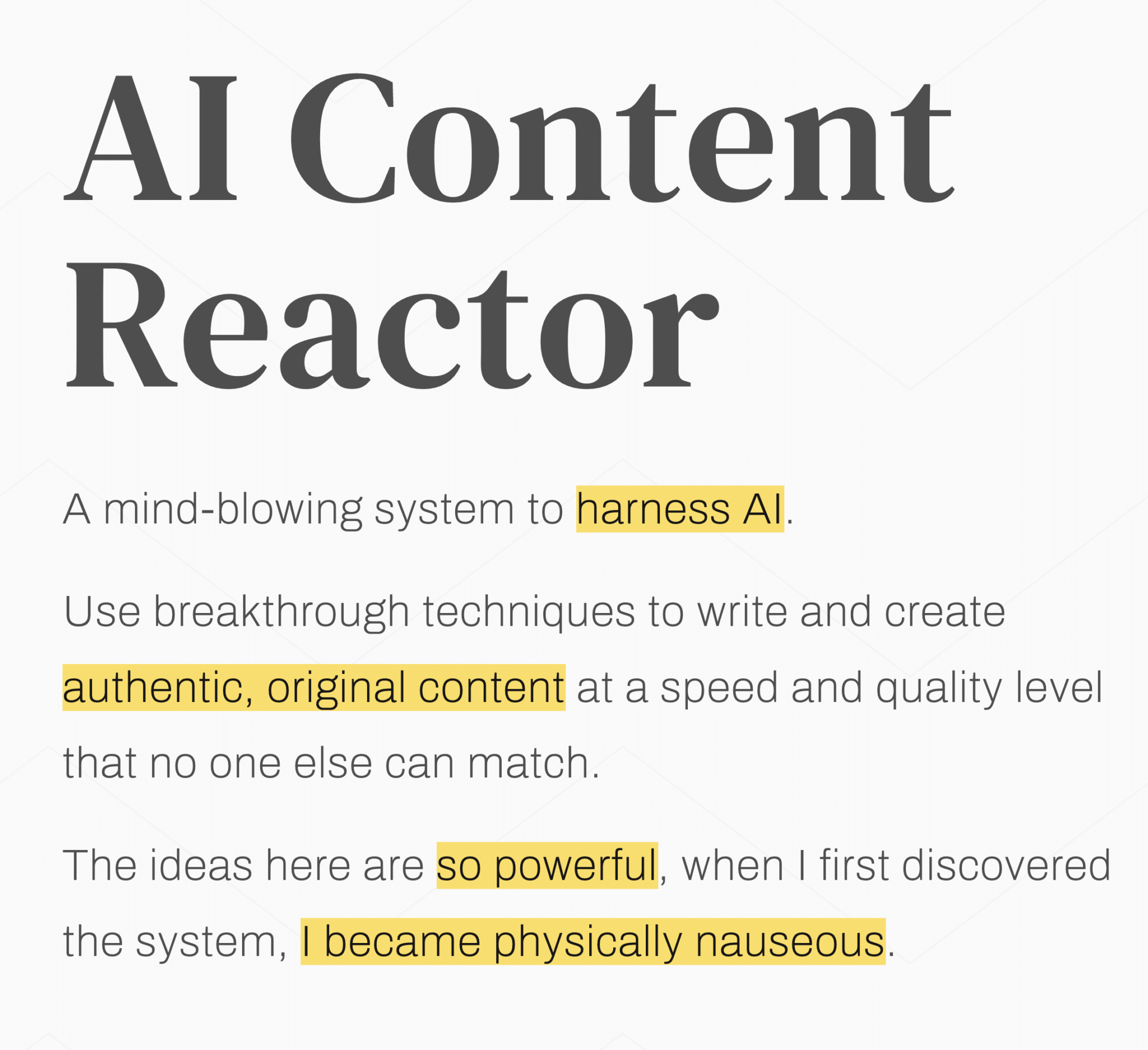We’ve gotten used to the terms “Web site” and “traffic”. Yet lately those have been undermined as third party platforms send fewer clicks to publishers. What now? If search no longer sends traffic, what’s left for business owners in a digital world? Focusing on your online presence is the key.
Table of contents
Do you remember the nineties?
When the Internet was still new it was hard to make sense of it. We had lots of early metaphors to be able to grasp it:
- cyberspace
- global village
- information superhighway.
We also used different terms to describe particular places online:
- home page
- web site
- online presence.
Some metaphors were still too broad or abstract. Others were too limiting. The term “home page” at first meant what we call a website today, later just the first and main page you see when you enter a site. The term “web site” sounded familiar and assuring so it stuck.
When I started using the Internet in the nineties most people still measured “hits”. I’m not talking about the Billboard charts, though! One person could spawn multiple hits! So it was just a vanity metric.
Those were the days before Google Analytics and similar advanced tools. We are in a phase of rapid change again, and now website and traffic metaphors also fade.
Are you into vanity metrics to feel better about yourself?
Website traffic was a vanity metric from day one. Yet for many years it was the most reliable metric. Most others only worked in connection with it. Things like bounce rate, pages per visit/session or exit rate help you assess what really happens.
Yet traffic alone is not sufficient. It just makes you feel good that a thousand visitors appeared on your site. Did they really though?
Let’s examine what a website and traffic really mean.
What’s a web site, really?
What is a “web site” essentially? Like a real-world location, it has an address and it is somewhere physical: on a server. Yet, that’s not the point. The point is, you don’t really go there. It’s a virtual place; you can look at the site – at least, using a browser – but you can’t go.
Technically, visiting a website is more like a phone call, where the caller usually says nothing. In most cases, a website interaction is like someone calling you and hanging up quickly. If you have a high bounce rate, you’re getting a lot of hang-ups.
So unless you’re into ghost stories a website isn’t really what we picture. We may talk about “going,” or “visiting,” but those are just words we use because they’re familiar. It’s not really like a location where you go and see people visiting or walking around.
While website analytics tools can measure website traffic, this is why the numbers are often pointless without context.
What about traffic?
“Traffic” already says it all. It’s like people driving by your physical location on a busy street. It’s not really actual people yet because you can’t see much of them. It’s just a car zooming by. You don’t even know how many people are in the car. In the early days we didn’t even know how many of them actually stopped.
-And, these cars may not even have a driver. Your traffic can also be bot traffic.
So, as you can see, measuring website traffic without more accurate and significant metrics always fell short.
In 2025 most people don’t visit websites much.
So where do people go nowadays? Essentially, by now, they often go nowhere.
- Searchers often stay on Google.
- Social media users stay on social media sites/apps.
- AI tools rephrase third party content without attribution.
As long as we still measure success through website traffic metrics, we may realize that it dwindles – no matter how successful our search and social media efforts are.
But, when we look beyond the vanity metrics we realize that it’s not as bad as it looks. What we then discover is that the current reality is more about online presence.
Popular brands are usually present all over the Web, and it’s not just in business. You probably have social accounts on many sites. Personal branding like this ensures people look for your name on third party services.
How do you embrace your online presence then?
Look for your ideal audience! Where is it?
- Do they already talk about you?
- Do they ask questions you could answer?
- Do they face issues you could help them with?
Join the party!
The “join the conversation” slogan is a popular social media trope. Yet it’s still true. You don’t exist on social media when you don’t say anything.
So interact proactively. Answer questions, be helpful, socialize, engage.
Now that Google favors some specific sites like Reddit and Quora and many smaller forums, you may have to reconsider your social media approach. Simply chatting on yesterday’s news sites like X/Twitter and Facebook (where updates vanish quickly or never even get indexed) may not be enough anymore.
LinkedIn is another platform that gets much more reach on search now, also due to Google’s AI features according to an Advanced Web Ranking study:
“We found that two major domains are featured most frequently in the AI Overviews:
- linkedin.com with 2.79% of queries
- youtube.com with 2.29% of queries”
Google’s own YouTube also shows up prominently. So it might be a good idea to increase efforts there. Advanced Web Ranking, Semrush and Ziptie are three tools that allow you to check whether you appear in AI Overviews.
Do the small talk.
Answer questions on forums, in communities or social media like Reddit and Quora. Provide quick answers on your site that Google can use for their AI Overviews, featured snippets and People Also Ask questions.
Ideally others talk about you on your behalf. So also nurture brand evangelists like bloggers and influencers. Don’t just flood Q&A sites yourself, though. Rather, approach existing power users and let them share genuine insights.
Both Siege Media and WordLift provide comprehensive guides on how to contribute to niche communities on Reddit.
Move to deep talk.
Most people will just be satisfied with the quick and dirty answer. That’s fine! Only the important ones – potential clients – go further.
Provide the “read more” deep insights on your website. You can even block Google from showing them using a “nosnippet” tag. Just make sure that you don’t spend all your content and social SEO budget on third party sites. Always treat your own website as a hub for efforts all over your online presence.
You can even nurture leads on third party tools yet, when it comes to selling something, it’s often still best to come back home. How?
Invite them home!
When answering questions on forums or social media, make sure to add a call to action for people to visit your website. You can also let them download a PDF, watch a video – whatever brings them lower in the sales funnel or further in the customer journey. Where necessary literally state that you can’t disclose everything in a short comment thread or answer.
Be clear enough without promoting yourself too much. That might backfire. Something like “I can’t just copy and paste my 3k word guide here. Visit my website for that one,” is honest enough without being pushy.
What should you measure?
Now that we’ve stopped focusing solely on the legacy website traffic metaphor we may add more meaningful online presence metrics.
It’s not just that traffic is drying up. Many people probably won’t even need to visit your site when they buy something. So, you may want to know what happens where, and which efforts actually pay off, across your whole online presence. They may look up your phone number on Google e.g. and call you directly.
Using a “dashboard” tool like Databox can save a lot of time, effort and take the guesswork out of holistic online presence analytics. Beyond traffic, conversions and sales also look for the following:
Brand Sentiment
Even when you don’t represent a global brand you may want to find out what people think about you in general.
Our Level343 name is a brand that is already recognizable. So even a free tool like this one from Hootsuite can tell you a bit already. Level343 is “neutral” as of late 24.
Your brand sentiment can also be negative or positive, obviously, so it’s a good idea to find out before you leave money on the table. For more in depth brand sentiment analysis you may want to use tools that measure it regularly over time. Consider Hootsuite, socialinsider, Keyhole, Cision or survicate.
Engagement (Rate)
Most social media tools show you meaningless metrics like impressions or views. This often just means that something appeared on the screen and could be possibly seen. Yet given how often pages get reloaded and how cluttered streams are, this number is often way too inflated. You can only be sure of those who actually performed an action, either on social sites or your website.
Google Analytics allows you to track engagement (rate) on your site. You can compare yours to the average in your industry based on this case study: “The average engagement rate across industries and company types is 62%.”
Ideally you also measure it across the Web on third party apps like Instagram, X/Twitter or Pinterest, for example.
Results
So at the end of the day what are the results of all your online presence efforts?
You may find out that some campaigns or sites perform better than others. Or you may notice that on some sites people merely discover you while just a small percentage of them finally buy something when they search for your name on Google.
No matter what you measure it’s important to get a bigger picture beyond mere website traffic. You want to know what happens across your properties and accounts all over the Web.
Otherwise some of it may appear futile while beneficial campaigns may get overlooked just because they don’t lead to direct sales.



































